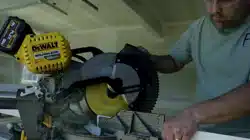Loading ...
Loading ...
Loading ...

English
14
When smoothest cuts are desired for molding and other precision work, a sharp (60 tooth
carbide) blade and a slower, even cutting rate will produce the desired results.
Ensure that the material does not move or creep while cutting; clamp it securely in place.
Always let the blade come to a full stop before raising arm.
If small fibers of wood still split out at the rear of the workpiece, stick a piece of masking tape
on the wood where the cut will be made. Saw through the tape and carefully remove tape
when finished.
For varied cutting applications, refer to the list of recommended saw blades for your saw and
select the one that best fits your needs. Refer to Saw Blades under Accessories.
CLAMPING THE WORKPIECE
WARNING: A workpiece that is clamped, balanced and secure before a cut may become
unbalanced after a cut is completed. An unbalanced load may tip the saw or anything the
saw is attached to, such as a table or workbench. When making a cut that may become
unbalanced, properly support the workpiece and ensure the saw is firmly bolted to a stable
surface. Personal injury may occur.
WARNING: The clamp foot must remain clamped above the base of the saw whenever
the clamp is used. Always clamp the workpiece to the base of the saw – not to any other part
of the work area. Ensure the clamp foot is not clamped on the edge of the base of the saw.
CAUTION: Always use a work clamp to maintain control and reduce the risk of workpiece
damage and personal injury, if your hands are required to be within 6" (152mm) of the blade
during the cut.
If you cannot secure the workpiece on the table and against the fence by hand (irregular
shape, etc.), or your hand would be less than 6" (152 mm) from the blade, a clamp or other
fixture must be used.
Use the material clamp provided with your saw. To purchase the material clamp, contact your
local retailer or D
E
WALT service center.
Other aids such as spring clamps, bar clamps or C-clamps may be appropriate for certain
sizes and shapes of material. Use care in selecting and placing these clamps. Take time to
make a dry run before making the cut. The left or right fence will slide from side to side to aid
in clamping.
TO INSTALL CLAMP
1. Insert it into the hole (AA, Fig. 4) behind the fence. The clamp should be facing toward the
back of the miter saw. The groove on the clamp rod should be fully inserted into the base.
Ensure this groove is fully inserted into the base of the miter saw. If the groove is visible,
the clamp will not be secure.
2. Rotate the clamp 180º toward the front of the miter saw.
3. Loosen the knob to adjust the clamp up or down, then use the fine adjust knob to firmly
clamp the workpiece.
NOTE: Place the clamp on the opposite side of the base when beveling. ALWAYS MAKE
DRY RUNS (UNPOWERED) BEFORE FINISH CUTS TO CHECK THE PATH OF THE BLADE.
ENSURE THE CLAMP DOES NOT INTERFERE WITH THE ACTION OF THE SAW OR
GUARDS.
Support for Long Pieces
WARNING: To reduce the risk of serious personal injury, turn tool off and remove
the battery packs or power supply before transporting, making any adjustments,
cleaning, repairing, or removing/installing attachments or accessories. An accidental
start-up can cause injury.
ALWAYS SUPPORT LONG PIECES.
Never use another person as a substitute for a table extension, as additional support for a
workpiece that is longer or wider than the basic miter saw table or to help feed, support or
pull the workpiece.
FIG. 20A
PROPER CUT
PROPER CUT
IMPROPER CUT
IMPROPER CUT
IMPROPER CUT
FIG. 20B
Loading ...
Loading ...
Loading ...
